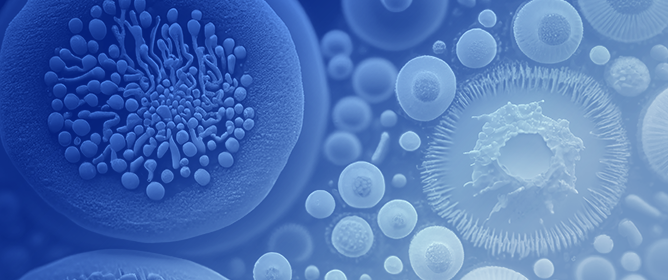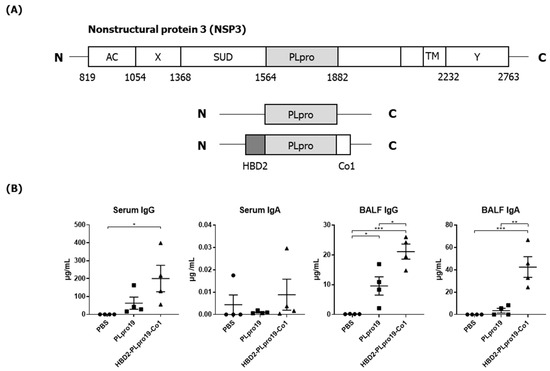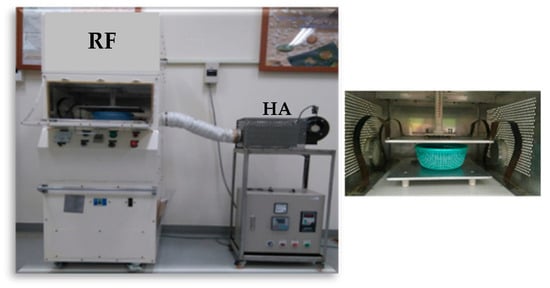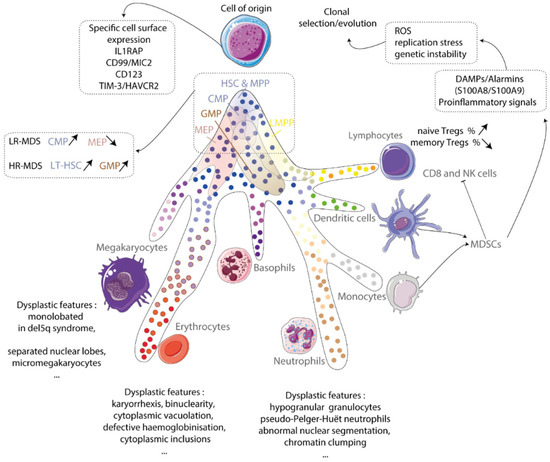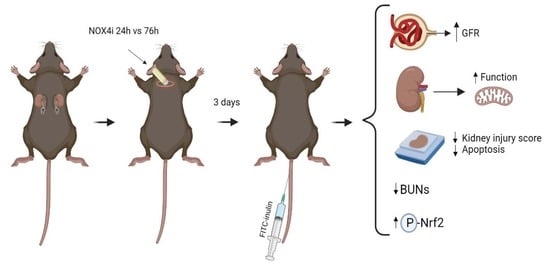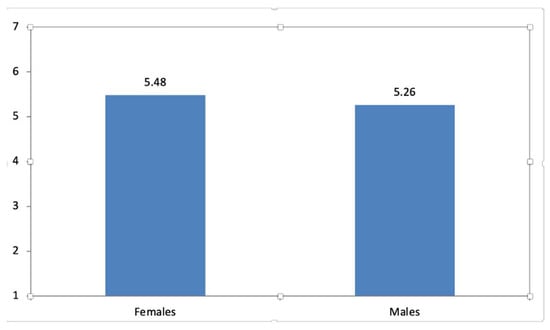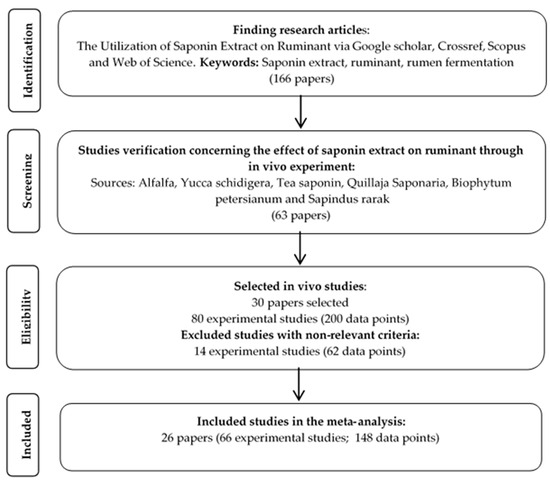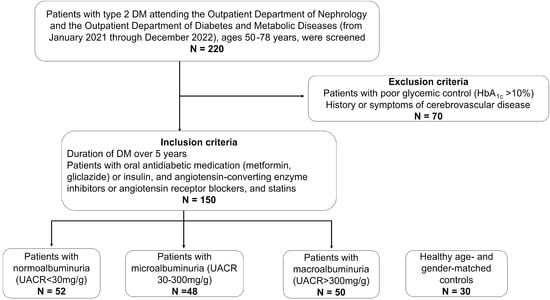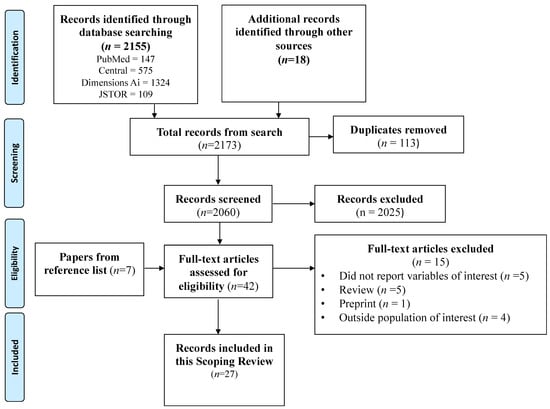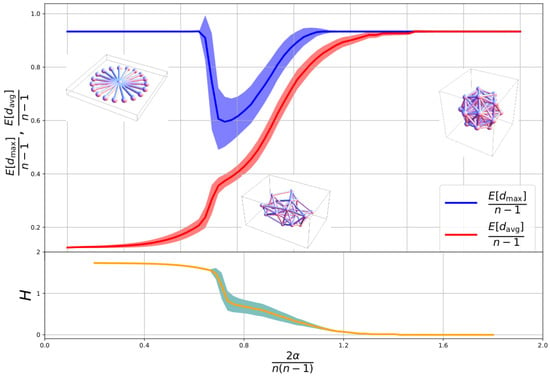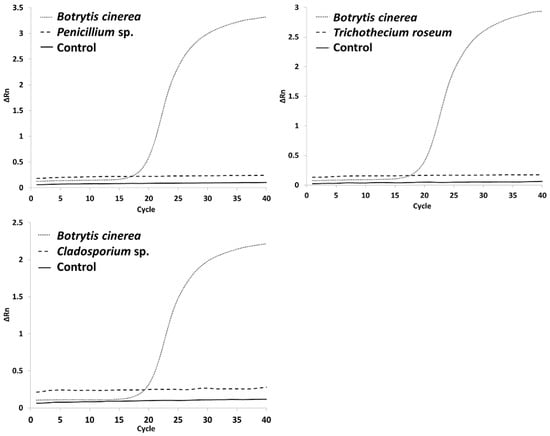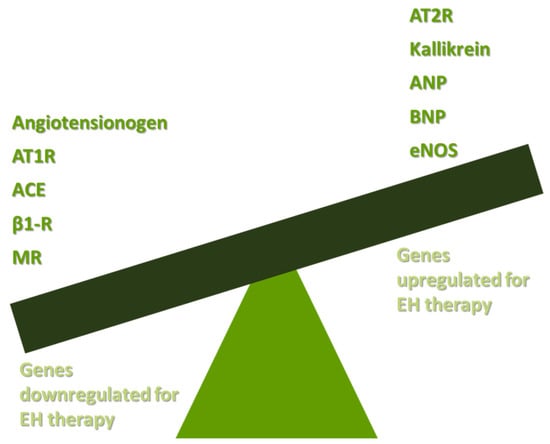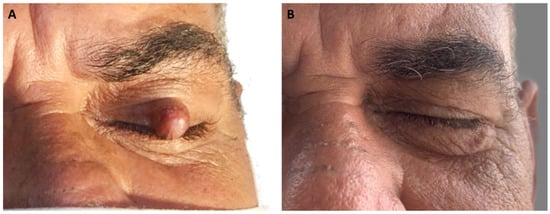Cerebrovascular disease accounts for major neurologic disabilities in patients with type 2 diabetes mellitus (DM). A potential association of mitochondrial DNA (
mtDNA) and inflammation with cerebral vessel remodeling in patients with type 2 DM was evaluated. A cohort of 150 patients and 30 healthy controls were assessed concerning urinary albumin/creatinine ratio (UACR), synaptopodin, podocalyxin, kidney injury molecule-1 (KIM-1), N-acetyl-β-(D)-glucosaminidase (NAG), interleukins IL-17A, IL-18, IL-10, tumor necrosis factor-alpha (TNFα), intercellular adhesion molecule-1 (ICAM-1).
MtDNA-CN and nuclear DNA (
nDNA) were quantified in peripheral blood and urine by qRT-PCR. Cytochrome b (
CYTB) gene, subunit 2 of NADH dehydrogenase (
ND2), and beta 2 microglobulin nuclear gene (
B2M) were assessed by TaqMan assays.
mtDNA-CN was defined as the ratio of the number of
mtDNA/nDNA copies, through analysis of the
CYTB/B2M and
ND2/B2M ratio; cerebral Doppler ultrasound: intima-media thickness (IMT)—the common carotid arteries (CCAs), the pulsatility index (PI) and resistivity index (RI)- the internal carotid arteries (ICAs) and middle cerebral arteries (MCAs), the breath-holding index (BHI). The results showed direct correlations of CCAs-IMT, PI-ICAs, PI-MCAs, RI-ICAs, RI-MCAs with urinary
mtDNA, IL-17A, IL-18, TNFα, ICAM-1, UACR, synaptopodin, podocalyxin, KIM-1, NAG, and indirect correlations with serum
mtDNA, IL-10. BHI correlated directly with serum IL-10, and serum
mtDNA, and negatively with serum IL-17A, serum ICAM-1, and NAG. In neurologically asymptomatic patients with type 2 DM cerebrovascular remodeling and impaired cerebrovascular reactivity may be associated with
mtDNA variations and inflammation from the early stages of diabetic kidney disease.
Full article
 IJMS
IMPACT
IJMS
IMPACT Applied Sciences
IMPACT
Applied Sciences
IMPACT Sustainability
IMPACT
Sustainability
IMPACT Sensors
IMPACT
Sensors
IMPACT JCM
IMPACT
JCM
IMPACT Energies
IMPACT
Energies
IMPACT Molecules
IMPACT
Molecules
IMPACT Materials
IMPACT
Materials
IMPACT Remote Sensing
IMPACT
Remote Sensing
IMPACT Cancers
IMPACT
Cancers
IMPACT Electronics
IMPACT
Electronics
IMPACT Mathematics
IMPACT
Mathematics
IMPACT Foods
IMPACT
Foods
IMPACT Buildings
IMPACT
Buildings
IMPACT Plants
IMPACT
Plants
IMPACT Nutrients
IMPACT
Nutrients
IMPACT Animals
IMPACT
Animals
IMPACT Polymers
IMPACT
Polymers
IMPACT Water
IMPACT
Water
IMPACT Diagnostics
IMPACT
Diagnostics
IMPACT Biomedicines
IMPACT
Biomedicines
IMPACT Agronomy
IMPACT
Agronomy
IMPACT Microorganisms
IMPACT
Microorganisms
IMPACT Processes
IMPACT
Processes
IMPACT Healthcare
IMPACT
Healthcare
IMPACT Forests
IMPACT
Forests
IMPACT Cells
IMPACT
Cells
IMPACT JMSE
IMPACT
JMSE
IMPACT Medicina
IMPACT
Medicina
IMPACT Viruses
IMPACT
Viruses
IMPACT Agriculture
IMPACT
Agriculture
IMPACT Nanomaterials
IMPACT
Nanomaterials
IMPACT IJERPH
IJERPH
 Land
IMPACT
Land
IMPACT Pharmaceutics
IMPACT
Pharmaceutics
IMPACT Pharmaceuticals
IMPACT
Pharmaceuticals
IMPACT Religions
IMPACT
Religions
IMPACT Biomolecules
IMPACT
Biomolecules
IMPACT Life
IMPACT
Life
IMPACT Micromachines
IMPACT
Micromachines
IMPACT Atmosphere
IMPACT
Atmosphere
IMPACT Antioxidants
IMPACT
Antioxidants
IMPACT Genes
IMPACT
Genes
IMPACT Metals
IMPACT
Metals
IMPACT Symmetry
IMPACT
Symmetry
IMPACT Children
IMPACT
Children
IMPACT Coatings
IMPACT
Coatings
IMPACT Vaccines
IMPACT
Vaccines
IMPACT Horticulturae
IMPACT
Horticulturae
IMPACT Education Sciences
IMPACT
Education Sciences
IMPACT Minerals
IMPACT
Minerals
IMPACT Brain Sciences
IMPACT
Brain Sciences
IMPACT JPM
IMPACT
JPM
IMPACT Bioengineering
IMPACT
Bioengineering
IMPACT


